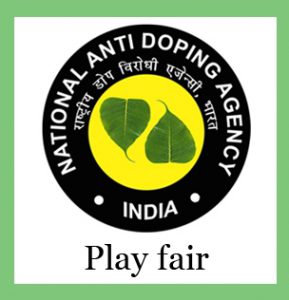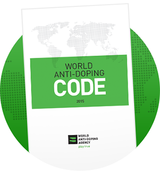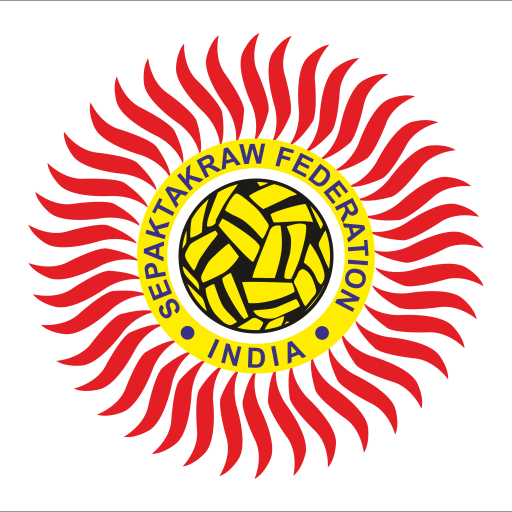ANTI DOPING
In pursuance of the decision of the World Anti Doping Agency (WADA) to make amendments to the existing WADA Code 2009, the Government of India, Ministry of Youth Affairs and Sports hereby notifies the amended National Anti Doping Rules of NADA laying down the condition for athletes and athlete’s support personnel for participation in sports event, as also the manner of collection of samples for conduct of result management of dope test results and conduct of disciplinary and appeal panel proceedings at national level.
These revised Anti Doping Rules in compliance to new WADA Code 2015 will apply to the whole of India and would be deemed to effect from 1st January 2015.
 |
DOPING In order to enhance their performance, sportsmen use specific ‘methods’ that optimize the qualities needed for their sport, on the basis of various physiological, biological, psychological factors. |
 |
|---|

NADA : The National Anti-Doping Agency
The National Anti-Doping Agency(NADA) is the national organization responsible for promoting, coordinating, and monitoring the doping control program in sports in all its forms in the country. NADA works towards a vision of ’dope free’ sport in India.
NADA’S PRIMARY FUNCTIONS
- Adopting and implementing anti-doping rules and policies which conform with the World Anti- Doping Code,
- Cooperating with other sports related organizations and other anti-doping organizations,
- Encouraging reciprocal testing between National Anti-Doping Organizations, and
- Promoting anti-doping research & education
CODE
The World Anti-Doping Code (Code) is the document that harmonizes regulations regarding anti-doping in sport across all sports and all countries of the world. The Code provides a framework for anti-doping policies, rules, and regulations for sport organizations and public authorities so that there may be a level playing field for all athletes worldwide.
ANTI DOPING RULE VIOLATIONS
- Doping is defined by WADA as the occurrence of one or more of the following anti-doping rule violations mentioned in the WADA/NADA Code.
- Presence of a prohibited substance or its metabolites or markers in an athlete’s sample.
- Use or attempted use by an athlete of a prohibited substance or a prohibited method.
- Refusing to submit to sample collection after being notified.
- Failure to provide whereabouts information or being unavailable for doping control.
- Tampering with any part of the doping control process.
- Possession of a prohibited substance or method.
- Trafficking a prohibited substance or method.
- Administering or attempting to administer a prohibited substance or method to an athlete.
- Complicity
- Prohibited Association
PROHIBITED SUBSTANCES AND METHODS
- The World Anti-Doping Agency annually updates the List of Prohibited Substances and Methods. The list is the International Standard defining what is prohibited in-competition and out-of-competition. The list also indicates whether particular substances are banned in particular sports.
ATHLETES RESPONSIBILITIES
- In accordance with WADA Code the athletes are responsible whenever a prohibited substance is found in their bodily specimen. This means that a violation occurs whether or not the athlete intentionally or unintentionally, knowingly or unknowingly, used a prohibited substance or was negligent or otherwise at fault.
LATEST INFORMATION
- Athletes should always check with their National Federations/ International Federations (IFs) to find out what additional substances and methods are prohibited in their sports. Also, athletes should always make their doctor aware that they are bound by the specific rules of their sport. Those who are unsure of what a product contains should not take it until they are sure it is not prohibited. Ignorance is never an excuse.
DOPING CONTROL
- Doping controls or athlete testing are carried out in accordance with the Code and the International Standard for Testing. Athletes who compete at the international and national level may be tested anytime, anywhere. Specially trained and accredited doping control personnel carry out all tests.
TESTING
- NADA is responsible to implement an effective number of in-competition and out-of-competition tests on the athletes in its registered testing pool. This includes international and national level athletes being tested by NADA. The NADA develops a test distribution plan and allocates the number of samples for each sport or discipline required for effective deterrence. The plan includes out-of-competition testing, in- competition testing, and may include blood as well as urine collection.
IN-COMPETITION TESTING
- NADA coordinates in-competition testing so that there is only one organization testing at one event. Criteria for the selection of athletes are predetermined, based on the regulations of the relevant IF or event ruling body. Athletes are notified of theirs election for testing immediately following competition, and sample collection takes place in accordance with the International Standard for Testing. Samples are analyzed for “in-competition substances” as outlined in the WADA Prohibited List.
OUT-OF-COMPETITION TESTING
- Out-of-competition testing or any testing done outside of an event ensures that all athletes can be tested at any time and at any place. An athlete identified in the registered testing pool by NADA is required to provide accurate and current whereabouts information. This information is usually required on a half- yearly basis, although NADA may have specific requirements, and updates are required if the athlete’s plans change. Whereabouts information may include details such as home address, work schedule, training venues and schedule, and competition schedule anything which will help a Doping Control Officer (DCO) find the athlete on any given day. International or national level athletes identified in a registered testing pool are responsible under the Code for providing whereabouts information to NADA. Failure to do so in accordance with anti-doping regulations may be considered an anti-doping rule violation and may result in a sanction.
https://www.nadaindia.org/en/prohibited-list-2021
https://www.nadaindia.org/en/harmful-effects-of-doping
https://www.nadaindia.org/en/therapeuticuseexemptionstue
1) Consequences of Anti – Doping Rules Violation
A Player’s or other person’s violation of an anti – doping rule may result in one or more of the following:
- Disqualification Means the player is not longer allowed to take part in a particular Competition or Event, with all resulting consequences including forfeiture of any medals, points and prizes.
- Ineligibility Means the Player or other person is barred for a specified period of time from participating in any competition or to other activity.
- Provisional Suspension Means the Player or other person is barred temporarily from participating in any Competition prior to the final decision at a hearing.
2) Doping Control
The process including test, distribution planning, Sample collection & handling, laboratory analysis, results management, hearings and appeals.
3) National Anti-Doping Organization (NADO)
The entity (ies) designated by each country as possessing the primary authority and responsibility to adopt and implement anti-doping rules, direct the collection of samples, the management of test results, and the conduct of hearings, all at the national level. If this designation has not been made by the competent public authority (ies), the entity shall be the country’s National Olympic Committee or its designee.
4) No Advance Notice
A Doping Control which takes place with no advance warning to the PLAYER and where the PLAYER is Continuously chaperoned from the moment of notification through sample provision.
5) No Fault or Negligence
The Sepaktakraw player establishing that he or she did not know or suspect, and could not reasonably have known or suspected even with the exercise of utmost caution, that he or she had used or been administered the prohibited substance or prohibited method.
6) No Significant Fault or Negligence
The Sepaktakraw Player establishing that his or her fault or negligence, when viewed in the totality of the circumstances and taking into account the criteria for No Fault or Negligence, was not significant in relationship to the anti-doping rule violation.
The Complete and Updated information cane be obtained from the official site of WADA www.wada-ama.org
